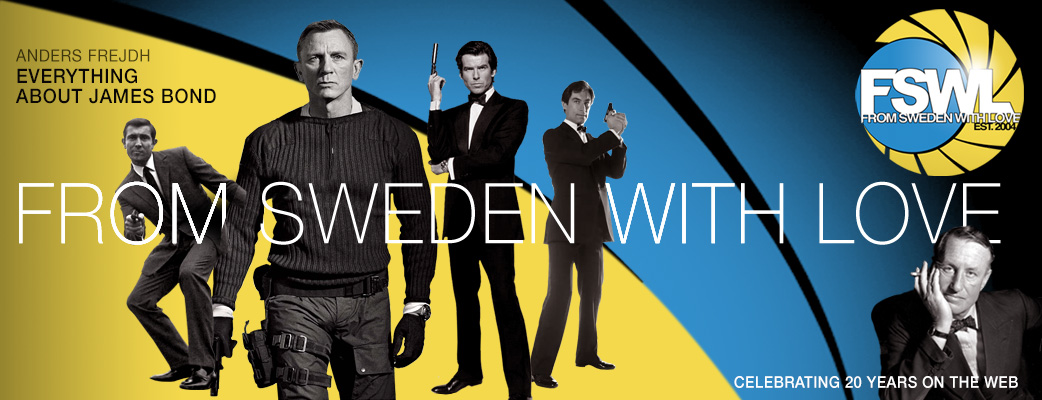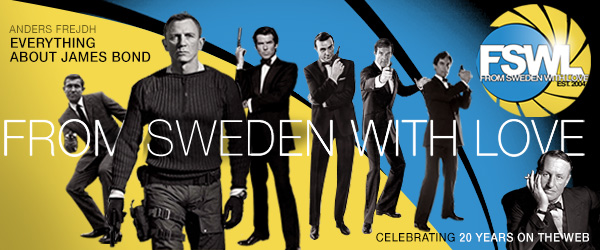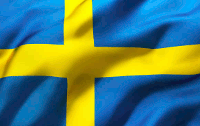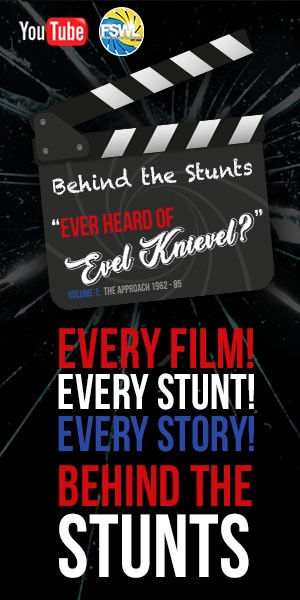Website last updated: 26-4-2024
Home
Book & Film reviews
Competitions
Event
FSWL Merchandise
In Memoriam
Interviews
James Bond 007 collection
James Bond 007 films
James Bond 007 games
James Bond 007 literature
James Bond 007 news
James Bond 007 products
James Bond 007 shop
James Bond 007 stars
James Bond Fan Clubs
Swedes in the Bond films
From Scotland with Love: FSWL's Brian Smith on Sean Connery
By: Brian Smith
Published:
2020-11-02
2020-11-02
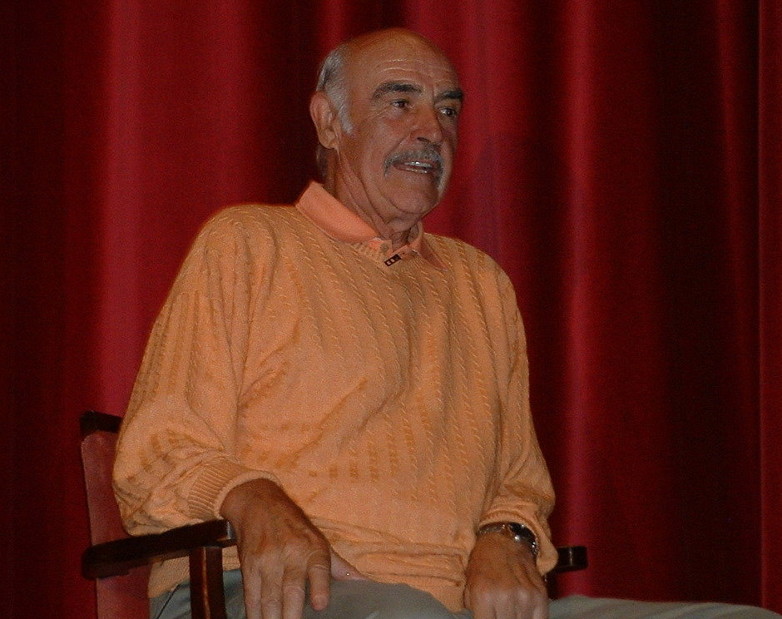
SeanŌĆÖs brother Neil Connery, who still lives in Edinburgh, was too upset to talk yesterday. His wife Eleanor said that ŌĆśNeil is very sad and distressed at losing his older brother.ŌĆÖ His son Jason said in a statement that it was a ŌĆśsad day for all who knew and loved my dad and a sad loss for all people around the world who enjoyed the wonderful gift he had as an actor.ŌĆÖ
Born in 1930, the two brothers were raised in Fountainbridge, one of the poorest areas of Edinburgh at that time. Later, Eleanor would take umbrage at anyone who referred to their tenement building as a slum. She said that the boysŌĆÖ mother, Effie, maintained a spotlessly clean home and stair (the communal steps to the tenement flats).
The route from Co-op milkman via the Royal Navy to international movie star was hardly an obvious one, but success in the Mr Universe competition and a subsequent tour in the chorus line of SOUTH PACIFIC proved the turning point.
In 1953 the cast formed a ŌĆśSouth Pacific Soccer XIŌĆÖ. It was during a match with the Manchester United junior team that legendary manager Matt Busby ŌĆō another great Scot - spotted ConneryŌĆÖs potential and offered him a trial. An enthusiastic Connery told Robert Henderson, who was the leading American actor in the show, about the offer. ŌĆśThe advice which this remarkable man then gave me would change my life,ŌĆÖ recalled Connery in his memoir, BEING A SCOT (Weidenfeld & Nicolson, 2008). Henderson advised Connery that a career in football may only last ten years whereas as an actor, you could go on and on. However, he pointed out two problems. First was his ŌĆśnear-impenetrable Scots burr,ŌĆÖ and second was that he would have to educate himself. ŌĆśI had been given a definitive direction to do something in life and have half a chance to be somebody.ŌĆÖ
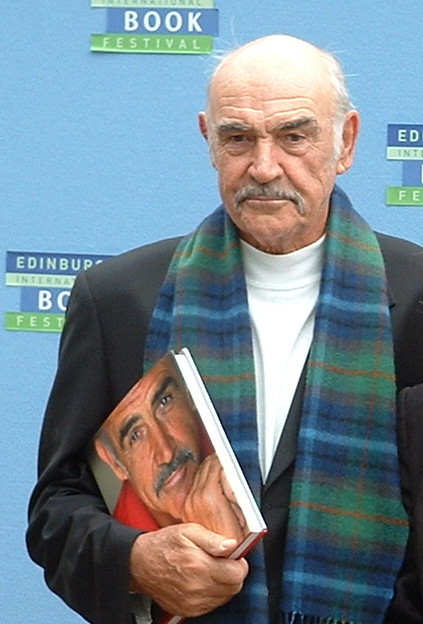
Sean Connery Being A Scot International Book Festival. Photo by Brian James Smith. All rights reserved.
Seven years later, hard work and modest success in theatre, film and television, brought Connery to the attention of film producers Harry Saltzman and Albert ŌĆśCubbyŌĆÖ Broccoli. Connery auditioned for James Bond and secured the role six months ahead of filming Dr. No (1962). He wasnŌĆÖt quite what Ian Fleming had in mind when he was writing his books, but any concerns the bestselling author may have had were quickly dispelled when he saw Sean in action in Jamaica.
Fleming already had an unused Scottish backstory for James Bond but had never disclosed much about his hero (FlemingŌĆÖs own father was born in Newport-on Tay, a small Scottish town in north-east Fife). While Dr. No was shooting, Fleming was writing On Her Majesty's Secret Service (1963) at Goldeneye. In this new book he revealed that BondŌĆÖs father was Scottish as a tacit nod to his approval of Connery. In the following novel, You Only Live Twice (1964), we learn that Bond was expelled from Eton and finished his education at Fettes, the public school in Edinburgh. Ironically, the closest Connery got to Fettes was when he used to deliver milk there.
ConneryŌĆÖs dissatisfaction with the Bond role by the time of his fifth film, You Only Live Twice (1967) has been well documented. He was lured back for Diamonds Are Forever in 1971 (leaving George Lazenby to wear the kilt in 1969's On Her Majesty's Secret Service) with the then unheard of fee of $1.25 million which he used to set up the Scottish International Education Trust to ŌĆśgive financial help to men and women who show exceptional ability and promise.ŌĆÖ Connery was grateful for the help given to him by Robert Henderson and believed ŌĆśother talented Scots deserved a ŌĆ£leg upŌĆØ too.ŌĆÖ Diamonds Are Forever opened in London without the usual premiere, but it received a Gala Premiere at the Odeon, Clerk Street, Edinburgh on 14 January, 1972.
As part of the Bond deal United Artists financed The Offence (1973), probably ConneryŌĆÖs most powerful screen performance.
ConneryŌĆÖs career in the 1970s never reached the heights of James Bond although he gave many fine performances in films such as Murder on the Orient Express (1974), The Man Who Would Be King (1975) with Michael Caine, Robin and Marian (1976), opposite Audrey Hepburn (all of his merry men with the exception of Ronnie BarkerŌĆÖs Friar Tuck had Scottish accents!), and The First Great Train Robbery (1978).
His 1983 comeback as James Bond in Never Say Never Again (1983) began something of a renaissance for Connery. A slew of hit movies followed - Highlander (1986), The Name of the Rose (1986) for which he won the BAFTA Best Actor award, The Untouchables (1987) which garnered him an Oscar and a Golden Globe, The Presidio (1988), and as Harrison FordŌĆÖs father in Steven SpielbergŌĆÖs Indiana Jones and the Last Crusade (1989).
The following decade produced another string of hits, including The Hunt For Red October (1990), The Russia House (1990), Medicine Man (1992), Rising Sun (1993), A Good Man In Africa (1994, written by future Bond novelist William Boyd), Just Cause (1995), First Knight (1995), Dragonheart (1996), The Rock (1996) and Entrapment (1999). He even returned under the official Bond banner to record his voice for the 2005 video game of the 1963 film From Russia with Love.
Around this time, Scotland began to take notice of his achievements. On 8 July, 1988 Connery received an honorary degree from the University of St Andrews. In 1991 he was awarded the Freedom of the City of Edinburgh ŌĆśfor his tremendous achievements as an ambassador for EdinburghŌĆÖ and for recognising ŌĆśhis longstanding commitment to the education of young people in Scotland, and his artistic contribution to motion pictures.ŌĆÖ The UK House of Commons applauded ŌĆśthe decision of the City of Edinburgh Council to confer the Freedom of the City on the distinguished actor Sean ConneryŌĆÖ.
Six weeks short of his 70th birthday, Connery knelt before the Queen at the Palace of Holyroodhouse, Edinburgh to receive his knighthood. The investiture drew a line under a political controversy that had denied him this honour in previous years. Afterwards he said, ŌĆśItŌĆÖs one of the proudest days of my life.ŌĆÖ
Although he was a well-known advocate for Scottish independence, he lived abroad for the last 47 years. In a sense his outlook was actually less as a nationalist and more as an internationalist; he never missed an opportunity to promote Scotland around the world. ŌĆśHe hovers over Scotland,ŌĆÖ Billy Connolly once joked, ŌĆślike a great colossus ŌĆō from the Bahamas!ŌĆÖ
Sean Connery's emotional BAFTA Fellowship acceptance speech in 1998
Tributes came from across the political spectrum - such was the esteem in which he was held. ScotlandŌĆÖs First Minister Nicola Sturgeon said, ŌĆśSean was a global legend but, first and foremost, he was a patriotic and proud Scot.ŌĆÖ Former British Prime Minister Gordon Brown said on Twitter that he was ŌĆśsorry to see that Sean Connery passed away. I enjoyed many conversations with him over the years.ŌĆÖ
Former First Minister Henry McLeish added, ŌĆśHe always carried Scotland with him, taking a great pride in his country. No one can forget his great and varied acting career and for many of us, the majority of us, he remains the only James Bond.ŌĆÖ
On 25 August, 2000, a double-bill screening of Dr. No and Indiana Jones and the Last Crusade was held in the shadow of Edinburgh Castle. The evening was called ŌĆśA Knight Under The StarsŌĆÖ and was co-organised by the Edinburgh Fringe Festival and the Edinburgh International Film Festival to honour Sir Sean on his 70th birthday.
Connery appeared at the Edinburgh International Book Festival on 25 August, 2008 to launch his memoir, BEING A SCOT. In front of a 300-strong crowd he discussed the book with his co-author Murray Grigor. The previous evening he introduced a rare screening of his 1965 masterpiece The Hill at EdinburghŌĆÖs Filmhouse Cinema. Connery was patron of the Edinburgh International Film Festival for almost twenty years, bowing out in 2010 with a screening of The Man Who Would Be King in the cityŌĆÖs Festival Theatre.
Sean Connery and his co-author Murray Grigor in the Bahamas before the launch
Connery effectively retired from films following The League Of Extraordinary Gentleman in 2003, although he did lend his voice to, and executive produced, the quirky animated Scottish movie Sir Billi (2012) for which Shirley Bassey recorded the title song.
Sean Connery was the only actor to explore the whole gamut of celluloid Bond, from the relatively faithful Fleming adaptations of Dr. No, From Russia with Love, Goldfinger (1964) and Thunderball (1965), to the science fiction grandeur of You Only Live Twice and the more comedic approach of Diamonds Are Forever which ushered in the 1970s. He was a Scottish icon, patriot and benefactor. As an actor, his legacy will endure. You only live once, but movies are forever.
Photos. Copyright ┬® 2020 Brian James Smith. All rights reserved.
Tags:
#articles
#brian_james_smith
#in_memoriam
#sean_connery
Tweet
